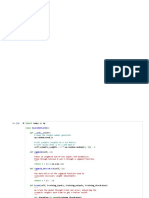0 ratings0% found this document useful (0 votes)
6 viewsPython 1
The document contains a Python implementation of a multilayer perceptron (MLP) neural network that uses the sigmoid activation function. It includes methods for forward propagation, backward propagation, and training the model on XOR logic gate data. The model is trained for 10,000 epochs and outputs predictions based on the input data.
Uploaded by
MOHAMMED BOUKANTARCopyright
© © All Rights Reserved
Available Formats
Download as DOCX, PDF, TXT or read online on Scribd
0 ratings0% found this document useful (0 votes)
6 viewsPython 1
The document contains a Python implementation of a multilayer perceptron (MLP) neural network that uses the sigmoid activation function. It includes methods for forward propagation, backward propagation, and training the model on XOR logic gate data. The model is trained for 10,000 epochs and outputs predictions based on the input data.
Uploaded by
MOHAMMED BOUKANTARCopyright
© © All Rights Reserved
Available Formats
Download as DOCX, PDF, TXT or read online on Scribd
You are on page 1/ 2
Python 1 :
import numpy as np
# Fonction d'activation sigmoid
def sigmoid(x):
return 1 / (1 + np.exp(-x))
# Dérivée de la fonction sigmoid
def sigmoid_derivative(x):
return x * (1 - x)
# Perceptron multicouche
class MLP:
def __init__(self, input_size, hidden_size, output_size):
# Initialisation des poids
self.weights_input_hidden = np.random.randn(input_size, hidden_size)
self.weights_hidden_output = np.random.randn(hidden_size, output_size)
self.bias_hidden = np.zeros((1, hidden_size))
self.bias_output = np.zeros((1, output_size))
def forward(self, X):
self.hidden_input = np.dot(X, self.weights_input_hidden) + self.bias_hidden
self.hidden_output = sigmoid(self.hidden_input)
self.final_input = np.dot(self.hidden_output, self.weights_hidden_output) + self.bias_output
self.final_output = sigmoid(self.final_input)
return self.final_output
def backward(self, X, y, learning_rate):
# Calcul des erreurs
output_error = y - self.final_output
output_delta = output_error * sigmoid_derivative(self.final_output)
hidden_error = output_delta.dot(self.weights_hidden_output.T)
hidden_delta = hidden_error * sigmoid_derivative(self.hidden_output)
# Mise à jour des poids et des biais
self.weights_input_hidden += X.T.dot(hidden_delta) * learning_rate
self.weights_hidden_output += self.hidden_output.T.dot(output_delta) * learning_rate
self.bias_hidden += np.sum(hidden_delta, axis=0, keepdims=True) * learning_rate
self.bias_output += np.sum(output_delta, axis=0, keepdims=True) * learning_rate
def train(self, X, y, epochs, learning_rate):
for _ in range(epochs):
self.forward(X)
self.backward(X, y, learning_rate)
# Exemples d'entrée et sortie
X = np.array([[0, 0], [0, 1], [1, 0], [1, 1]]) # Entrées (porte logique XOR)
y = np.array([[0], [1], [1], [0]]) # Sorties attendues
# Création et entraînement du modèle
model = MLP(input_size=2, hidden_size=4, output_size=1)
model.train(X, y, epochs=10000, learning_rate=0.1)
# Test du modèle
predictions = model.forward(X)
print(f"Prédictions :\n{predictions}")
You might also like
- Back Propagation Neural Network in PythonNo ratings yetBack Propagation Neural Network in Python2 pages
- Tugas Perceptron Dan BP Ann - A - f1d019055 - M. ArfriyandriNo ratings yetTugas Perceptron Dan BP Ann - A - f1d019055 - M. Arfriyandri3 pages
- Data Science - Neural Network from ScratchNo ratings yetData Science - Neural Network from Scratch1 page



























































